How Long Does Covid Live on Pillows
Very interesting question “How long does covid live on pillows?”. If you’re reading this, I’m guessing you’re keen to understand more about the behavior of the Covid virus, particularly around its lifespan on various surfaces like pillows. Given how pervasive this virus has been, and the impact it’s had on our lives, your curiosity is absolutely justified. Let’s delve in, shall we?
The Lifespan of Covid on Surfaces – What We Know
When it comes to understanding the lifespan of Covid on surfaces, it’s crucial to remember that this virus is surprisingly resilient. Research has shown that the virus can survive on various surfaces for different lengths of time, depending on factors such as the material of the surface, environmental conditions, and even the specific strain of the virus.
In particular, Covid has been found to live on plastic and stainless steel for up to 72 hours. This longevity of the virus on surfaces is part of what makes it so infectious, as people can contract the virus by touching contaminated surfaces and then touching their face, particularly their mouth, nose, or eyes.
Covid on Soft Surfaces – How Long Does Covid Live on Pillows
So what does this mean for soft surfaces like pillows? It’s not uncommon for us to spend significant amounts of time close to our pillows, especially while sleeping. This close contact may raise questions and concerns about the potential for pillows to harbor the virus.
The fabric and porous nature of pillows may make them less hospitable to the virus compared to harder surfaces. However, this doesn’t mean that pillows are completely safe. Depending on the circumstances, pillows could potentially still host the virus for a certain amount of time, which is something to be aware of in our efforts to stay safe.
Studies and Observations of How Long Does Covid Live on Pillows
Research specifically focused on the survival of Covid on pillows is somewhat limited. Nevertheless, it’s possible to draw some inferences from studies conducted on similar materials. For example, porous surfaces like fabrics have been found to be capable of hosting the virus for varying lengths of time.
Generally speaking, it’s thought that the virus could potentially survive on fabric surfaces for up to 24 to 48 hours. However, it’s worth noting that the exact duration can vary depending on various factors, such as the specific fabric, as well as environmental conditions like temperature and humidity. Understanding these variables is key in managing the risk of virus transmission. While it’s clear that the risk isn’t zero, knowledge of these factors can empower us to take appropriate precautions and minimize potential risks.
 Foto: Pixabay
Foto: Pixabay
Minimizing Risks: Keeping Covid from Living on Your Pillows
So, what can we do about this? Well, first of all, don’t panic. There are several steps you can take to minimize risk and keep your pillows as germ-free as possible.
Frequent Cleaning
Regular cleaning is the first line of defense. Consider washing your pillowcases at least once a week on a hot cycle. Also, don’t forget about the pillow itself! Most pillows can be cleaned in the washing machine every few months.
Use of Pillow Protectors
Now, one of the potential ways to help mitigate the risk of transmission of Covid through pillows is the use of pillow protectors. You may be asking: “What exactly are pillow protectors?” Well, as the name suggests, these are covers that are designed to envelop your pillows, adding an extra layer of material between the pillow itself and the pillowcase.
Pillow protectors serve a variety of functions. First and foremost, they provide a physical barrier that can prevent the virus from reaching the surface of your pillow. This is significant because even if the virus is able to survive on the pillow protector, it is much easier to remove and wash the protector than it is to clean the entire pillow.
Moreover, pillow protectors are generally made from materials that can withstand high-temperature washing. This means that you can frequently wash your pillow protectors on a hot cycle, which is a reliable method for killing the virus. By using a pillow protector, you’re adding another layer of defense in your fight against Covid.
In addition to their protective role, pillow protectors also have other benefits. They can extend the lifespan of your pillows, and provide protection against allergens, dust mites, and other potential irritants. So while the use of pillow protectors is particularly relevant in the context of Covid. I’s also a good practice for maintaining overall cleanliness and hygiene.
Final Thoughts and Practical Suggestions
In essence, while it’s possible that Covid can live on your pillows for a certain amount of time. It’s important not to let this fact fuel anxiety. Instead, use it as a reminder to maintain good hygiene practices, including regular cleaning and maybe investing in a pillow protector. Remember, knowledge is power. By understanding more about the virus and how it operates, we can all take the right steps to keep ourselves and our loved ones safe.




